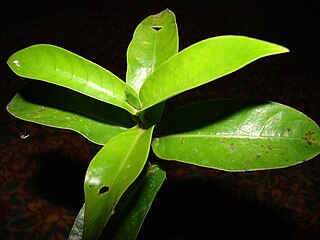Astronidium degeneri is a species of plant in the family Melastomataceae. It is endemic to Fiji.
Astronidium is a genus of plants in family Melastomataceae. It contains the following species :

Labordia is a genus of plant in family Loganiaceae. There are 16 species all endemic to Hawaii. It is closely related to Geniostoma
Myrsine degeneri, the summit colicwood, is a species of plant in the family Primulaceae. It is endemic to the island of Oahu in Hawaii.

Myrsine is a genus of flowering plants in the family Primulaceae. It was formerly placed in the family Myrsinaceae before this was merged into the Primulaceae. It is found nearly worldwide, primarily in tropical and subtropical areas. It contains about 200 species, including several notable radiations, such as the matipo of New Zealand and the kōlea of Hawaiʻi. In the United States, members of this genus are known as colicwood. Some species, especially M. africana, are grown as ornamental shrubs.

Korthalsella is a genus of flowering plants in the sandalwood family, Santalaceae. It contains about 25 species distributed in Asia, Africa, Australia, New Zealand, and some Pacific Islands.

Lipochaeta, common name nehe, is a genus of flowering plants in the family Asteraceae that is endemic to Hawaii.
Aldo Stella was an Italian historian specialising in the Italian Anabaptist movement.
Kadua degeneri is a rare species of flowering plant in the coffee family known by the common names Waianae Range starviolet and Degener's bluet. It is endemic to Hawaii, where it is known only from the island of Oahu. There are four known populations totalling 370 individuals. It is a federally listed endangered species of the United States.
Melicope degeneri is a rare species of flowering plant in the family Rutaceae known by the common names Kokee Stream melicope and Degener's pelea. It is endemic to Hawaii, where it is known only from the island of Kauai. It is a federally listed endangered species of the United States. Like other Hawaiian Melicope, this species is known as alani.

Penstemon degeneri is a species of flowering plant in the plantain family known by the common name Degener's beardtongue. It is endemic to Colorado in the United States, where it occurs in and around the Arkansas River Canyon in Fremont, Custer, and Chaffee Counties.
Anaerococcus is a genus of bacteria. Its type species is Anaerococcus prevotii. These bacteria are Gram-positive and strictly anaerobic. The genus Anaerococcus was proposed in 2001. Its genome was sequenced in August 2009. The genus Anaerococcus is one of six genera classified within the group GPAC. These six genera are found in the human body as part of the commensal human microbiota.
Peptoniphilus gorbachii is a Gram-positive and anaerobic bacterium from the genus of Peptoniphilus which has been isolated from a human abscess from Los Angeles in the United States.

Ophionereis is a genus of echinoderms belonging to the family Ophionereididae.
Anaerococcus hydrogenalis is a bacterium from the family Peptoniphilaceae. It is present in vaginal discharges and ovarian abscesses. Presence of Anaerococcus hydrogenalis in the gut metabolism and their coline consumption has been associated to cardiovascular diseases. Contrary to most of the species in this genus, Anaerococcus hydrogenalis is indole-positive. Also, some strains in this specie can produce urease.
Anaerococcus tetradius is a bacterium from the family Peptoniphilaceae. It was first isolated from vaginal discharges and ovarian abscesses, but is a common member of the vaginal flora.
Anaerococcus lactolyticus is a bacterium from the family Peptoniphilaceae. A. lactolyticus along A. vaginalis can be a dominant species in Diabetic foot and pressure ulcers. It can also participate in polymicrobial infections of the urinary tract.
Anaerococcus murdochii is a bacterium from the family Peptoniphilaceae. A. murdochii has been reported from skin and wound infections. Resistance or reduced susceptibility to several antibiotics, such as colistin sulphate, clindamycin and kanamycin A or penicillin has been reported.
Anaerococcus nagyae is a bacterium from the family Peptoniphilaceae. It was first found in a blood culture from a patient with ischemia and influenza. The cells of Anaerococcus nagyae are arranged in pairs. Although it can weakly ferment mannose, studies has shown this anaerobic bacteria can not ferment glucose and raffinose. A. nagyae is resistant to colistin, but it is susceptible to vancomycin and kanamycin.





